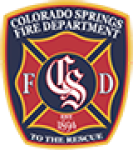Prevent Carbon Monoxide Poisoning
The Colorado Springs Fire Department wants you to be aware of the dangers of carbon monoxide poisoning. Often called the invisible killer, carbon monoxide is an odorless, colorless gas created when fuels (such as gasoline, wood, coal, natural gas, propane, oil, and methane) burn incompletely. In the home, heating and cooking equipment that burn fuel are potential sources of carbon monoxide. Vehicles or generators running in an attached garage can also produce dangerous levels of carbon monoxide.
SAFETY TIP:
CO alarms should be installed in a central location outside each sleeping area and on every level of the home.
The dangers of CO exposure depend on a number of variables, including the victim's health and activity level. Infants, pregnant women, and people with physical conditions that limit their body's ability to use oxygen (i.e. emphysema, asthma, heart disease) can be more severely affected by lower concentrations of CO than healthy adults would be.
A person can be poisoned by a small amount of CO over a longer period of time or from a large amount of CO over a shorter amount of time. CO enters the body through breathing. CO poisoning can be confused with flu symptoms, food poisoning and other illnesses. Some symptoms include shortness of breath, nausea, dizziness, light headedness or headaches. High levels of CO can be fatal, causing death within minutes.

Action Steps You Can Take
- Follow the manufacturer’s instructions for placement and mounting height.
- Choose a CO alarm that has the label of a recognized testing laboratory.
- Test CO alarms at least once a month; replace them according to the manufacturer’s instructions.
- If the audible trouble signal sounds, check for low batteries. If the battery is low, replace it. If it still sounds, call 9-1-1.
- If the CO alarm sounds, immediately move to a fresh air location outdoors or by an open window or door
- Gas or charcoal grills can produce CO — only use outside.
- If you need to warm a vehicle, remove it from the garage immediately after starting it.
- Do not run a vehicle or other fueled engine or motor indoors, even if garage doors are open. Make sure the exhaust pipe of a running vehicle is not covered with snow.
- During and after a snowstorm, make sure vents for the dryer, furnace, stove, and fireplace are clear of snow build-up.
You can download and print this Carbon Monoxide Safety flier for more information.

